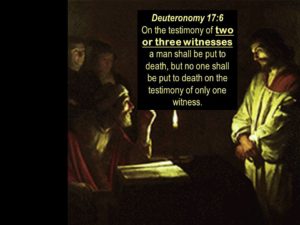[Greek] συμφωνέω (symphōneō), [Latin] consentire, [Latin[ convenire, [Latin] concordare: to be in harmony, to be in accord, to “sound together”, to agree, to have singleness of mind; Lk.5:6, Act.15:15, Mt. 18:19-20, Act 5:9, Mt.20:2

It was necessary for two or three witnesses to “sound together” (agree) in their testimony to bring charges to the accused.
Background Information:
Greek culture: As with other later cultures, the Greeks utilized this Greek term in several ways. This term can be used to denote the fitting of one piece to the larger total part (the fitting together of stones in a building). This term is also used in the working together to achieve a positive purpose (political treaties and economical contracts). This working together can also be used for an evil or negative purpose (conspiring). This term conveys the sense of agreeing with (championing the views of the prophets, supporting others’ political views). Finally, this term can be used negatively to express the sense of discrepancy.
Old Testament: This Greek term is found in the gathering of conspiring kings (Gen.14:3). The Syrian army gathered together in Ephraim (Isa.7:2). The priests agreed that they would not take funds from the people to repair the temple (2 Kgs.12:9). The Hebrews viewed harmony and agreement as the order of the world as God created it. The Law of God is the standard in which the Hebrews contemplated their world. Hence, the will of God revealed in the Law was a norm of true life and conduct. This was the society shaped by the Law. In Deut.17:6 the Hebrews established the practice of identifying others who transgressed the Covenant. This included doing evil in the sight of the Lord, transgressing the covenant, or worshipping other gods. A thorough investigation and producing witness testimony was necessary to sentence this person to death by stoning. The testimony of two or three witness was required for putting this person to death. No one shall be put to death on the testimony of only one witness. The two or three witnesses must be of the same voice (sound together) in order to put this person to death.
Early Christianity: Ignatius of Antioch (110 A.D) uses the Greek term to portray the unity of the Church. The unity of the Church is already achieved by Christ, but it is to be kept by the members of the community with a common mind. The unity of the Church does not rest on uniformity but on the relationships in the hierarchical Church structure: the members to the bishop, the bishop to Christ, Christ to God.
Scripture:
“He told them a parable. ‘No one tears a piece from a new cloak to patch an old one. Otherwise, he will tear the new and the piece from it will not match the old cloak.”” Lk.5:36
Jesus speaks of the unsuitability of combining the old with the new. There is no harmony.
“The words of the prophets agree with this, as it is written.” Act.15:15
The agreements speaks of supporting tradition and a like-mind belief systems.
“Then Peter said to her, ‘Why did you agree to test the Spirit of the Lord? Listen, the footsteps of those who have buried your husband are at the door, and they will carry you out.’” Act.5:9
The sin of Ananias and Saphira is in conspiring together in their deception of the community. Their deaths are ascribed to a lie to the Holy Spirit.
“Again, I say to you, if two of you agree on earth about anything for which they are to pray, it shall be granted to them by My heavenly Father. For where two or three are gathered together in My name, there am I in the midst of them.” Lk. 18:19-20
The speakers may be plural, but the mouth is a singular voice. This speaks of a message or request of unity and blessing. Jesus, becoming in their midst, guarantees the efficacy of prayer.

A wind flute: a possible precursor to the modern day bagpipes
Conclusion:
Symphony, symphonic, consent, convene, concord
A symphony is collection of musical instruments playing a specific part. These sounds, although different, come together in a harmonious arrangement. These musical instruments “sound together” in creating a unified arrangement. A symphony is also a specific type of musical composition. It was interesting to note that there was very little reference to the musical aspects of this Greek term. However, there is a mention of a dulcimer (wind instrument) in Daniel 3:5. This was most likely the precursor to the modern day bagpipes.
Jesus borrows from the idea of bringing of two or more together but in a positive sense. This unity or “sounding together” indicates that Jesus is in their midst.
